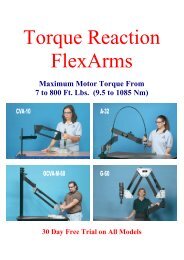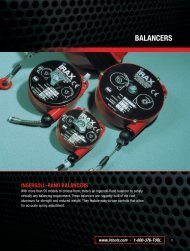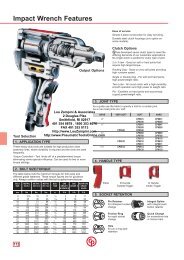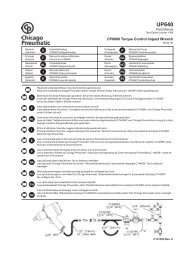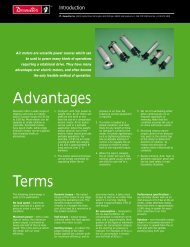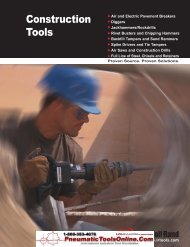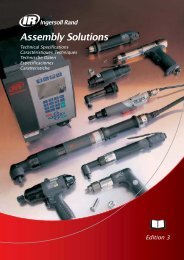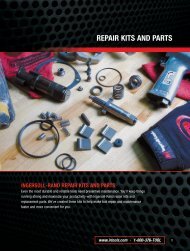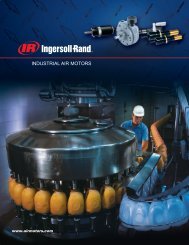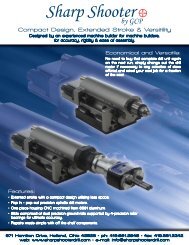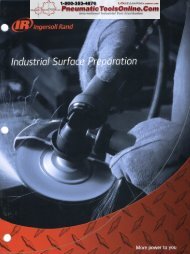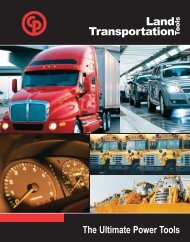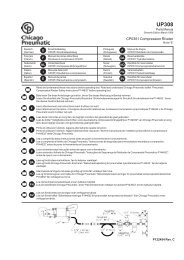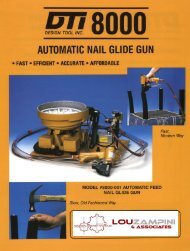RediPower - Pneumatic Tools Online
RediPower - Pneumatic Tools Online
RediPower - Pneumatic Tools Online
Create successful ePaper yourself
Turn your PDF publications into a flip-book with our unique Google optimized e-Paper software.
Safety instructions<br />
General Safety Instructions for the Operation of Power <strong>Tools</strong><br />
The goal of is to produce tools that help the<br />
operator work safely and efficiently.<br />
The most important safety device for this or<br />
any other tool is the operator. Care and<br />
good judgement are the best protection<br />
against injury.<br />
All possible hazards cannot be covered here,<br />
but we have tried to highlight some of the<br />
important ones.<br />
Individuals should look for and obey Caution,<br />
Warning and Danger signs placed on tools,<br />
and displayed in the workplace. Operators<br />
should read and follow safety instructions<br />
packed with each tool. For a copy of these<br />
instructions, contact your local representative.<br />
WARNING<br />
To reduce risk of injury everyone<br />
using, installing, repairing, maintaining,<br />
changing accessories on, or<br />
working near this tool must read and<br />
understand the safety instructions<br />
before performing any such task.<br />
Learn how each tool works. Even if you have<br />
previously used similar tools, carefully check<br />
out each tool before you use it. Get the ‘feel’<br />
of it and know its capabilities, limitations,<br />
potential hazards, how it operates and how it<br />
stops.<br />
All tools are designed to operate at a line<br />
pressure of 6.3 bar +/- 0.15bar in accordance<br />
with ISO2787.<br />
Sound levels +/- 3dB(A)* measured inaccordance<br />
with EN ISO15744. Vibration values*<br />
measured in accordance with ISO 8662.<br />
*These declared values were obtained by<br />
laboratory testing in compliance with stated<br />
standards and are not adequate for risk<br />
assessments. Values measured in individual<br />
work places may be higher than the declared<br />
values. The actual exposure values and risk<br />
of harm experienced by an individual are<br />
unique and depend upon the way the user<br />
works, the workplace and the work station<br />
design, as well as upon the exposure time<br />
and the physical condition of the user.<br />
We cannot be held liable for the consequences<br />
of using declared values, instead of<br />
values reflecting the actual exposure, in an<br />
individual risk assessment in a work place<br />
situation over which we have no control.<br />
<strong>Tools</strong> are CE marked to comply with<br />
European Machinery Directive.<br />
Specifications subject to change without<br />
prior notice.<br />
Further occupational health and safety<br />
information can be obtained from the<br />
following web sites:<br />
http://www.osha.gov (USA)<br />
http://europe.osha.eu.int (Europe).<br />
COMPRESSED AIR HAZARDS<br />
• Air under pressure can cause injury. Never<br />
point an air hose at yourself or anyone else.<br />
Never blow your clothes free of dust with<br />
compressed air. Always direct exhaust air<br />
away from yourself and others in the work<br />
area.<br />
• Always check for damaged or loose hoses<br />
and fittings before using an air tool, and<br />
replace if necessary. Whipping hoses can<br />
cause serious injury.<br />
• Disconnect the tool from the air supply<br />
when not in use, before changing accessories,<br />
setting the torque, or when making<br />
repairs.<br />
• Do not exceed rated air pressure to<br />
increase the output of the tool. This could<br />
cause injury and shorten tool life.<br />
• Do not assemble quick coupler on the tool.<br />
Vibration can cause breakage resulting in a<br />
whipping air hose. Instead, use quick<br />
couplers on the end of a short leader hose.<br />
• When universal twist couplings are used,<br />
lock pins must be installed to prevent<br />
accidental hose disconnection.<br />
• Air tools are not intended for use in<br />
explosive atmospheres and are not<br />
insulated for contact with electric power<br />
sources.<br />
ELECTRICAL HAZARDS<br />
• Power tool plugs must match the outlet.<br />
Never modify the plug in any way. Do not<br />
use any adapter plugs with earthed<br />
(grounded) power tools and equipment.<br />
Unmodifed plugs and matching outlets will<br />
reduce risk of electric shock.<br />
• Avoid body contact with earthed or<br />
grounded metal surfaces. There is an<br />
increased risk of electric shock if your body<br />
is earthed or grounded.<br />
• Do not abuse the cord. Never use the cord<br />
for carrying, pulling or unplugging the<br />
power tool. Keep cord away from heat, oil,<br />
sharp edges or moving parts. Damaged or<br />
entangled cords increase the risk of electric<br />
shock.<br />
• Do not expose electric power tools and<br />
equipment to wet conditions.<br />
• Do not operate power tools in explosive<br />
atmospheres. Power tools create sparks<br />
which may ignite dust, fumes or flammable<br />
liquids.<br />
• Have electric power tools and equipment<br />
serviced by a qualified repair person using<br />
only identical replacement parts.<br />
PROJECTILE HAZARDS<br />
• Always wear impact resistant eye and face<br />
protection when involved with or near the<br />
operation or repair of tools.<br />
BREATHING HAZARDS<br />
• Proper breathing protection must be worn<br />
when working with materials, which<br />
produce airborne particles.<br />
NOISE HAZARDS<br />
• Hearing loss can result from prolonged<br />
exposure to excessive sound levels.<br />
• Use hearing protection as recommended<br />
by your employer or Occupational Health<br />
and Safety Regulations.<br />
VIBRATION HAZARDS<br />
• Repetitive work motions, awkward<br />
positions, and exposure to vibration may<br />
be harmful to your hands and arms.<br />
• If numbness, tingling, pain or whitening of<br />
the skin occurs, stop using tool and consult<br />
a physician.<br />
ENTANGLEMENT HAZARDS<br />
• To reduce the risk of injury from entanglement,<br />
do not wear loose clothing when<br />
using rotating accessories.<br />
ADDITIONAL HAZARDS<br />
• Slip/Trip/Fall is a major cause of serious<br />
injury or death. Beware of excessive<br />
hose/cord left on the walking or work<br />
surface.<br />
• Operators and maintenance personnel<br />
must be physically fit to perform job tasks,<br />
and handle the bulk, weight and power of<br />
the tool.<br />
• Deburring tools should be used to reduce<br />
the risk of cuts and abrasions due to burrs.<br />
• Wear gloves to protect hands from sharp<br />
edges.<br />
48




